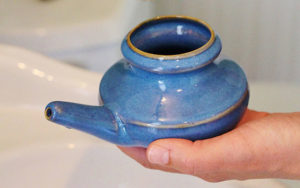 In Ayurveda, the accumulation of toxins in the body is called ama. It builds up as a result of the contaminants in our environment, improper eating habits, poor digestion, and/or a reflection of an imbalance in the gastrointestinal system.
In Ayurveda, the accumulation of toxins in the body is called ama. It builds up as a result of the contaminants in our environment, improper eating habits, poor digestion, and/or a reflection of an imbalance in the gastrointestinal system.
When these toxins are not properly digested and eliminated, they stagnate and can begin to compromise our health. Signs of this build-up include a coating on the tongue, foul-smelling breath or body odor, mental fog or confusion, weakness, body aches, diminished appetite, constipation, diarrhea, bloating, fatigue, lethargy, and overall heaviness—physically, mentally, and spiritually.
The practice of using a tongue scraper not only helps to removes metabolic waste and bacterial contamination that can accumulate on the tongue but also gives you the opportunity to be more present with the state of your health. In Ayurveda, the tongue is a road map to your internal organs and its examination can offer insight to digestive, assimilation and elimination disharmony as well as potential disease patterns of the lungs, heart, stomach, liver, spleen kidneys and intestines.This should be done daily to insure the stimulation of the internal organs, improve digestion, strengthen appetite and enhance the taste of food while increasing clarity of the mind and your spiritual awakening by reducing ama.
Dental research has also concluded that a tongue scraper is more effective at removing toxins and bacteria from the tongue than brushing the tongue with toothbrush. Although brushing and flossing will loosen and move debris, they do not actually remove decay-causing bacteria from the mouth. Most of our oral bacteria live on and in the deep crevices of our tongue and scraping the tongue collects this bacteria and other toxic so you can remove it from the body.
Tongue scrapers are made from many types of materials, such as gold, silver, copper, stainless steel, and plastic. The neutral choice I recommend is stainless steel, which is inexpensive, durable and easy to clean by rinsing it off and drying it after use. The procedure for scraping your tongue is to hold either end of the tongue scraper in each hand. Touch the round middle of the tongue scraper to the back of the tongue and firmly scrape from the back of the tongue to the front. Repeat this across the entire surface 8-12 times. Avoid rubbing back and forth or using such a heavy hand that you create irritation.
 The Neti Pot
The Neti Pot
After scraping your tongue, the next ritual in a supportive Dinacharya practice is nasal irrigation, commonly known as neti, often done with a neti pot. The yogis call this practice Jala Neti or Neti Kriya; the word kriya means cleansing practice. Neti rinses away buildup from the nasal passages and sinuses, including pollen, dust, germs, and other airborne contaminants and removes excess mucus. At the same time that it clears away these physical contaminates it can also help clear away the fog from the mind thereby increasing spiritual awareness.
Each day we take upwards of 17,000 inhalations and our nasal passages serve as an important filter between the atmosphere and our internal bodies, cleaning, heating and moisturizing the air as it enters the respiratory system. The moist membranes of the nasal passages secrete mucus which traps dust, dirt, and other airborne contaminants. This epithelial tissue also contains antibodies which is part of the body’s defense systems and with each breath the body’s natural defense system is active, collecting contaminants and protecting our lungs. Cleansing the nasal passages with a net pot helps to maintain the protective function of these tissues while clearing away dried mucus and stimulating fresh mucus.
The nose is divided into two passages separated by a septum; when you pour the salted water in one nostril, it goes around the back of the septum, and gravity helps it flow out the other side. The practice of using saline water in the nasal passages flushes out sinus fluids because the salt creates a higher osmotic pressure than water alone. The salt content of the water prevents the body from absorbing it, so it flushes easily for a cleansing effect.
According to Ayurvedic teachings a regular neti practice can have a positive effect creating overall balance to the entire central nervous, respiratory, circulatory, digestive and excretory systems. Yogis love neti for its ability to improve mental clarity, enhancing pranayama and meditation, and facilitating higher states of consciousness. Anyone can benefit from this practice, although it is especially recommended for people with chronic respiratory congestion, frequent colds, and sinus headaches but the practice is not recommend if you experience chronic nosebleeds, nasal polyps, or a deviated nasal septum.
When preforming neti it is recommend using distilled, purified or sterile water, which can be bought at the store, or use boiled water. Cleaning the neti pot is very easy by rinsing it with one of the waters above and let air dry.
When choosing a salt for your neti pot it is important to use a pure salt without caking additives, added chlorine, minerals, or flavorings. You can purchase specific neti salts or use food grade salt, including pure table, Kosher, Himalayan or Celtic salts. It is best to use a finely processed salt which will dissolve easily. After neti, you can use a nasya oil. It is important to note that the use of nasya oil should be done only after the nostrils are totally dry.
Benefits of Neti
Heightens and improves the sense of smell.
Relives respiratory conditions such as bronchitis, asthma, allergies, hay fever, colds, and postnasal drip.
Flushes out buildup from the nasal passages, including excess mucus, bacteria, dirt, and allergens.
Improves concentration and focus, visualization, and meditation.
Purifies the nadis (internal channels), which promotes awareness of the energetic system of the subtle body, facilitating the flow of prana (vital life force).
Moistens the nasal passages, reducing dryness.
How to Use a Neti Pot
*Place 1 cup of lukewarm water into your neti pot.
*Add ½ teaspoon of pure salt and allow to dissolve.
*Lean your head forward over the basin, gently place the spout of the neti pot inside your right nostril, forming a seal to avoid any leakage, and turn your head so your left nostril is pointed over the sink.
*Open your mouth slightly and breathe continuously through your open mouth.
*Slowly pour the solution into your right nostril and exhale through your mouth. The solution will flow through the nasal passage and out your left nostril and exit into the sink.
*Repeat with the neti pot inside your left nostril. When the neti pot is empty, remove the spout from your nostril and exhale through both nostrils.
*Gently blow your nose into a tissue a few times to expel all the water.
About the Author:
 Jeff Perlman studied nutrition before graduating from the Cordon Bleu and worked as a professional chef. After an injury and a health concern, he turned his attention to a holistic path and became a Certified Clinical Ayurvedic Practitioner, Panchakarma Specialist, Certified Massage-Marma Therapist, Registered AHG Herbalist, Iyengar Yoga instructor, and, certified IAYT-Ayuryoga Therapist. For more information visit his website. (Article reprinted from LA Yoga magazine)
Jeff Perlman studied nutrition before graduating from the Cordon Bleu and worked as a professional chef. After an injury and a health concern, he turned his attention to a holistic path and became a Certified Clinical Ayurvedic Practitioner, Panchakarma Specialist, Certified Massage-Marma Therapist, Registered AHG Herbalist, Iyengar Yoga instructor, and, certified IAYT-Ayuryoga Therapist. For more information visit his website. (Article reprinted from LA Yoga magazine)

